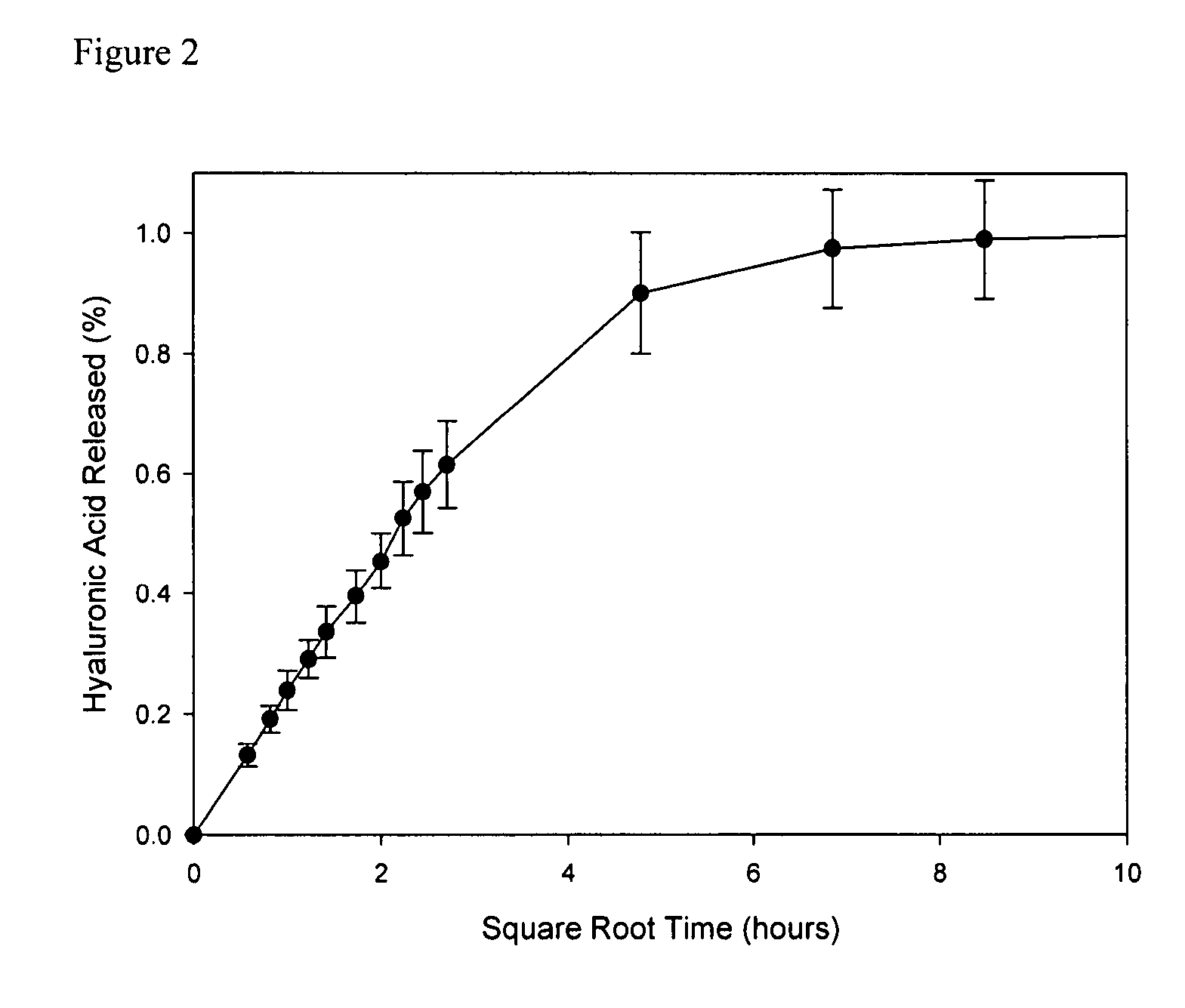Hyaluronic acid-retaining polymers
a technology of hyaluronic acid and polymer, which is applied in the field of hyaluronic acid retaining polymers, can solve the problems of reduced visual performance, in-eye wettability, and inability to absorb hyaluronic acid, and achieves low surface friction, improved properties, and low protein deposition properties.
- Summary
- Abstract
- Description
- Claims
- Application Information
AI Technical Summary
Benefits of technology
Problems solved by technology
Method used
Image
Examples
example 1
Preparation of an HA
Retaining Polymer
Materials
[0037]2-hydroxyethyl methacrylate (HEMA), ethylene glycol dimethacrylate (EGDMA), diaminobutane-4 (DAB-4) generation 1 dendrimer, 1-ethyl-3-(3-dimethylaminopropyl)-carbodiimide (EDC) and benzoyl peroxide were purchased from Sigma Aldrich (Oakville ON). IRGACURE was purchased from CIBA (Mississauga, ON). 35 kDa and 169 kDa hyaluronic acid were purchased from LifeCore Biomedical (Chaska, Minn.) while 900 kDa and fluorescently labeled HA were obtained from Sigma. Lysozyme (chick), human serum albumin (HSA), bovine β-lactoglobulin and immunoglobulin-G (IgG) (Human) were also obtained from Sigma.
Preparation of pHEMA Hydrogels
[0038]pHEMA membranes were prepared according to standard techniques. Briefly, HEMA monomer was purified to remove the 4-methoxyphenol (MEHQ) polymerization inhibitor by passing the monomer through a column packed with Aldrich inhibitor removers (Sigma-Aldrich, Oakville ON). HEMA and 1% by weight EGDMA were mixed. To this...
example 2
HA-Modified Silicone / HEMA Copolymer
Materials and Methods
[0070]IRGACURE was purchased from Ciba (Mississauga, ON). Methacryloxy propyl tris (trimethylsiloxy) silane (TRIS) was purchased from Gelest (Morrisville, Pa.). TRIS monomer and hydroxylethyl methacrylate (HEMA) monomer were purified to remove the 4-methoxyphenol (MEHQ) polymerization inhibitor by passing the monomer through a column packed with Aldrich inhibitor removers (Sigma-Aldrich, Oakville ON). HEMA, TRIS and 5% by weight ethylene glycol dimethacrylate (EGDMA) were mixed. Subsequently, 0.5% by weight IRGACURE was added and mixed thoroughly. The solution was poured into the custom Teflon® mold, placed in the UV chamber (Cure Zone 2 Con-trol-cure) and allowed to cure for 25 minutes. The surfaces were subsequently placed in an oven at 50° C. overnight to ensure complete reaction of the monomer. Following polymerization, the materials were removed from the molds and placed in water for over two days to remove any unreacted m...
PUM
| Property | Measurement | Unit |
|---|---|---|
| molecular weight | aaaaa | aaaaa |
| molecular weight | aaaaa | aaaaa |
| molecular weight | aaaaa | aaaaa |
Abstract
Description
Claims
Application Information
 Login to View More
Login to View More - R&D
- Intellectual Property
- Life Sciences
- Materials
- Tech Scout
- Unparalleled Data Quality
- Higher Quality Content
- 60% Fewer Hallucinations
Browse by: Latest US Patents, China's latest patents, Technical Efficacy Thesaurus, Application Domain, Technology Topic, Popular Technical Reports.
© 2025 PatSnap. All rights reserved.Legal|Privacy policy|Modern Slavery Act Transparency Statement|Sitemap|About US| Contact US: help@patsnap.com



